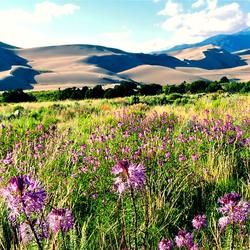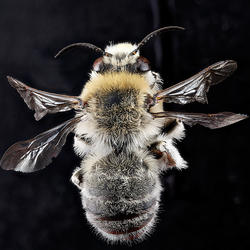Tricolored Bat hanging upside down in a cave. Photo by Andrea Schuhmann (USGS).
Why are pollinating bats, birds, bees, butterflies, and other animals important?
Do you enjoy a hot cup of coffee, a juicy peach, an-apple-a-day, almonds, rich and creamy dates, a handful of plump cashews, or vine-ripened tomatoes? Do you enjoy seeing the native flowers and plants that surround you?
If so, you depend on pollinators.
Wherever flowering plants flourish, pollinating bees, birds, butterflies, bats and other animals are hard at work, providing vital but often-unnoticed services. About three-fourths of all native plants in the world require pollination by an animal, most often an insect, and most often a native bee. Pollinators are also responsible for one in every three bites of food you take, and increase our nation’s crop values each year by more than 15 billion dollars.
Loss of pollinators threatens agricultural production, the maintenance of natural plant communities, and the important services provided by those ecosystems, such as carbon cycling, flood and erosion control, and recreation. Without pollinators providing the transportation of pollen from flower to flower, about 75 percent of all native North American plants could gradually become extinct as they lose the ability to reproduce.
Since bees are so small and accommodating, we can all do our own part by eliminating non-native weeds and shrubs and encouraging wildflowers to grow on our properties. Adding native flowering plants to even the smallest yard can help. The pollen and nectar from only about 5 flowers supports the food needs of a bee from egg to adulthood.
Learn more:
- North American Bat Monitoring Program (NABat)
- USGS Native Bee Inventory and Monitoring Program
- USGS Bee Inventory and Monitoring Lab on flickr (public domain images)
Related
Why are bats important?
Are honey bees native to North America?
Do bees feed on both nectar and pollen?
Do native bees occur on every continent on the planet?
Does the loss of plant diversity affect the health of native bees?
How many species of native bees are in the United States?
What is the role of native bees in the United States?

Tricolored Bat hanging upside down in a cave. Photo by Andrea Schuhmann (USGS).
Checkerspot butterfly on desert marigold in Lake Mead National Recreation Area
Checkerspot butterfly on desert marigold in Lake Mead National Recreation Area
Title: Bats in the West: Discoveries, Questions, and Future Research
By Gabriel A. Reyes, USGS Biologist
Title: Bats in the West: Discoveries, Questions, and Future Research
By Gabriel A. Reyes, USGS Biologist
The USGS Ecosystems Mission Area brings you Outstanding in the Field, a series of stories about our science, our adventures, and our efforts to better understand our fish and wildlife and the ecosystems that support them.
This is an animated GIF of a bee pollinating a flower. This video comes from The USGS Northern Prairie Wildlife Research Center, located in the Northern Great Plains state of North Dakota highlights their current and ongoing research on land use and pollinator health.
This is an animated GIF of a bee pollinating a flower. This video comes from The USGS Northern Prairie Wildlife Research Center, located in the Northern Great Plains state of North Dakota highlights their current and ongoing research on land use and pollinator health.
 Untapped Capacity: Our 4,000 Species of Native Bees
Untapped Capacity: Our 4,000 Species of Native Bees
So many unknowns and so many potentials.
So many unknowns and so many potentials.
Honey bees play a major role in pollinating the world’s plants, including those we eat regularly. However, land-use changes that decrease flower abundance can affect bee health and pollination services.
Honey bees play a major role in pollinating the world’s plants, including those we eat regularly. However, land-use changes that decrease flower abundance can affect bee health and pollination services.
The USGS Northern Prairie Wildlife Research Center, located in the Northern Great Plains state of North Dakota highlights their current and ongoing research on land use and pollinator health.
The USGS Northern Prairie Wildlife Research Center, located in the Northern Great Plains state of North Dakota highlights their current and ongoing research on land use and pollinator health.
Honey bee laden with pollen. Northern Prairie Wildlife Research Center has developed a genetic sequencing strategy to identify bee-collected pollen.
Honey bee laden with pollen. Northern Prairie Wildlife Research Center has developed a genetic sequencing strategy to identify bee-collected pollen.
A macrophotography image showing a native bee pollinating a native flower.
A macrophotography image showing a native bee pollinating a native flower.
A group of Rafinesque big-eared bats (and one southeastern myotis) found roosting in a bridge. Photo by Andrea Schuhmann (USGS).
A group of Rafinesque big-eared bats (and one southeastern myotis) found roosting in a bridge. Photo by Andrea Schuhmann (USGS).
It's Pollinator Week, and we're talking to USGS scientist Sam Droege about the tremendous importance of native bees and pollinators in general, and how you can lend a hand to these tiny titans.
An Eastern tiger swallowtail butterfly (female, black form) drinks nectar from a plumeless thistle flower in an abandoned agricultural field. Females have blue scales on the upper side of the lower hindwing.
An Eastern tiger swallowtail butterfly (female, black form) drinks nectar from a plumeless thistle flower in an abandoned agricultural field. Females have blue scales on the upper side of the lower hindwing.
Monarch butterfly on a dense blazing star.
Monarch butterfly on a dense blazing star.
Pollinator conservation and climate science at the U.S. Geological Survey
The bee lab
By land, air, and water — U.S. Geological Survey science supporting fish and wildlife migrations throughout North America
Flowering plants preferred by bees of the Prairie Pothole Region
Forage and habitat for pollinators in the northern Great Plains—Implications for U.S. Department of Agriculture conservation programs
U.S. Geological Survey science in support of the North American Bat Monitoring Program (NABat)
Assessing the impact of the Conservation Reserve Program on honey bee health
Identification of bees in southwest Idaho—A guide for beginners
National protocol framework for the inventory and monitoring of bees
Science from genes to landscapes
Mapping large-area landscape suitability for honey bees to assess the influence of land-use change on sustainability of national pollination services
Related
Why are bats important?
Are honey bees native to North America?
Do bees feed on both nectar and pollen?
Do native bees occur on every continent on the planet?
Does the loss of plant diversity affect the health of native bees?
How many species of native bees are in the United States?
What is the role of native bees in the United States?

Tricolored Bat hanging upside down in a cave. Photo by Andrea Schuhmann (USGS).
Tricolored Bat hanging upside down in a cave. Photo by Andrea Schuhmann (USGS).
Checkerspot butterfly on desert marigold in Lake Mead National Recreation Area
Checkerspot butterfly on desert marigold in Lake Mead National Recreation Area
Title: Bats in the West: Discoveries, Questions, and Future Research
By Gabriel A. Reyes, USGS Biologist
Title: Bats in the West: Discoveries, Questions, and Future Research
By Gabriel A. Reyes, USGS Biologist
The USGS Ecosystems Mission Area brings you Outstanding in the Field, a series of stories about our science, our adventures, and our efforts to better understand our fish and wildlife and the ecosystems that support them.
This is an animated GIF of a bee pollinating a flower. This video comes from The USGS Northern Prairie Wildlife Research Center, located in the Northern Great Plains state of North Dakota highlights their current and ongoing research on land use and pollinator health.
This is an animated GIF of a bee pollinating a flower. This video comes from The USGS Northern Prairie Wildlife Research Center, located in the Northern Great Plains state of North Dakota highlights their current and ongoing research on land use and pollinator health.
 Untapped Capacity: Our 4,000 Species of Native Bees
Untapped Capacity: Our 4,000 Species of Native Bees
So many unknowns and so many potentials.
So many unknowns and so many potentials.
Honey bees play a major role in pollinating the world’s plants, including those we eat regularly. However, land-use changes that decrease flower abundance can affect bee health and pollination services.
Honey bees play a major role in pollinating the world’s plants, including those we eat regularly. However, land-use changes that decrease flower abundance can affect bee health and pollination services.
The USGS Northern Prairie Wildlife Research Center, located in the Northern Great Plains state of North Dakota highlights their current and ongoing research on land use and pollinator health.
The USGS Northern Prairie Wildlife Research Center, located in the Northern Great Plains state of North Dakota highlights their current and ongoing research on land use and pollinator health.
Honey bee laden with pollen. Northern Prairie Wildlife Research Center has developed a genetic sequencing strategy to identify bee-collected pollen.
Honey bee laden with pollen. Northern Prairie Wildlife Research Center has developed a genetic sequencing strategy to identify bee-collected pollen.
A macrophotography image showing a native bee pollinating a native flower.
A macrophotography image showing a native bee pollinating a native flower.
A group of Rafinesque big-eared bats (and one southeastern myotis) found roosting in a bridge. Photo by Andrea Schuhmann (USGS).
A group of Rafinesque big-eared bats (and one southeastern myotis) found roosting in a bridge. Photo by Andrea Schuhmann (USGS).
It's Pollinator Week, and we're talking to USGS scientist Sam Droege about the tremendous importance of native bees and pollinators in general, and how you can lend a hand to these tiny titans.
An Eastern tiger swallowtail butterfly (female, black form) drinks nectar from a plumeless thistle flower in an abandoned agricultural field. Females have blue scales on the upper side of the lower hindwing.
An Eastern tiger swallowtail butterfly (female, black form) drinks nectar from a plumeless thistle flower in an abandoned agricultural field. Females have blue scales on the upper side of the lower hindwing.
Monarch butterfly on a dense blazing star.
Monarch butterfly on a dense blazing star.




















